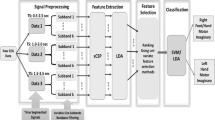Abstract
Pattern classification algorithm is the crucial step in developing brain–computer interface (BCI) applications. In this paper, a hierarchical support vector machine (HSVM) algorithm is proposed to address an EEG-based four-class motor imagery classification task. Wavelet packet transform is employed to decompose raw EEG signals. Thereafter, EEG signals with effective frequency sub-bands are grouped and reconstructed. EEG feature vectors are extracted from the reconstructed EEG signals with one versus the rest common spatial patterns (OVR-CSP) and one versus one common spatial patterns (OVO-CSP). Then, a two-layer HSVM algorithm is designed for the classification of these EEG feature vectors, where “OVO” classifiers are used in the first layer and “OVR” in the second layer. A public dataset (BCI Competition IV-II-a)is employed to validate the proposed method. Fivefold cross-validation results demonstrate that the average accuracy of classification in the first layer and the second layer is 67.5 ± 17.7% and 60.3 ± 14.7%, respectively. The average accuracy of the classification is 64.4 ± 16.7% overall. These results show that the proposed method is effective for four-class motor imagery classification.






Similar content being viewed by others
References
Ang KK, Chin ZY, Zhang H, Guan C (2008) Filter bank common spatial pattern (FBCSP) in brain–computer interface. In: IEEE international joint conference on neural networks, Hong Kong, China, pp 2390–2397
Brunner C, Naeem M, Leeb R, Graimann B, Pfurtscheller G (2007) Spatial filtering and selection of optimized components in four class motor imagery data using independent components analysis. Pattern Recogn Lett 28(8):957–964
Brunner C, Leeb R, Muller-Putz GR, Schlogl A, Pfurtscheller G (2008) BCI competition 2008-graz data set A, Institute for Knowledge Discovery (Laboratory of Brain–Computer Interfaces), Graz University of Technology
Chang C-C, Lin C-J (2011) LIBSVM: a library for support vector machines. Proc IEEE Int Conf Neural Netw 2(3):1–27
Dornhege G, Blankertz B, Curio G, Muller K-R (2004) Boosting bit rates in noninvasive EEG single-trial classifications by feature combination and multiclass paradigms. IEEE Trans Biomed Eng 51(6):993–1002
Fukuma R, Yanagisawa T, Yorifuji S, Kato R, Yokoi H (2015) Closed-loop control of a neuroprosthetic hand by magnetoencephalographic signals. PLoS ONE 10(7):e0131547
Galan F, Nuttin M, Lew E, Ferrez PW, Vanacker G, Philips J, Millan JDR (2008) A brain-actuated wheelchair: asynchronous and non-invasive brain–computer interfaces for continuous control of robots. Clin Neurophysiol 119(9):2159–2169
Grosse-Wentrup M, Liefhold C, Gramann K, Buss M (2009) Beamforming in non-invasive brain–computer interfaces. IEEE Trans Biomed Eng 56(4):1209–1219
Hadjidimitriou SK, Hadjileontiadis LJ (2012) Toward an EEG-based recognition of music liking using time-frequency analysis. IEEE Trans Biomed Eng 59(12):3498–3510
Kang H, Choi S (2014) Bayesian common spatial patterns for multi-subject EEG classification. Neural Netw 57(9):39–50
Kang H, Nam Y, Choi S (2009) Composite common spatial pattern for subject to subject transfer. IEEE Signal Process Lett 16(8):683–686
Koles ZJ (1991) The quantitative extraction and topographic mapping of the abnormal components in the clinical EEG. Electroencephalogr Clin Neurophysiol 79(6):440–447
Krusienski DJ, Sellers EW, McFarland DJ, Vaughan TM, Wolpaw JR (2008) Towardenhanced p300 speller performance. J Neurosci Methods 167(1):15–21
Lin Z, Zhang C, Wu W, Gao X (2007) Frequency recognition based on canonical correlation analysis for SSVEP-based BCIs. IEEE Trans Biomed Eng 54(6):1172–1176
Lotte F, Guan C (2011) Regularizing common spatial patterns to improve BCI designs: unified theory and new algorithms. IEEE Trans Biomed Eng 58(2):355–362
Martens S, Leiva J (2010) A generative model approach for decoding in the visual event-related potential-based brain–computer interface speller. J Neural Eng 7(2):1393–1402
Pfurtscheller G, Neuper C, Birbaumer N (2005) Human brain-computer interface. In: Vaadia E, Riehle A (eds) Motor cortex in voluntary movements: a distributed system for distributed functions, Methods and New Frontiers in Neuroscience. CRC Press, Boca Raton, pp 367–401
Ramoser H, Muller-Gerking J, Pfurtscheller G (2010) Optimal spatial filtering of single trial EEG during imagined hand movement. IEEE Trans Rehabil Eng 8(4):441–446
Salvaris M, Sepulveda F (2009) Visual modifications on the p300 speller BCI paradigm. J Neural Eng 6(4):046011
Suk HI, Lee SW (2011) Subject and class specific frequency bands selection for multiclass motor imagery classification. Int J Imaging Syst Technol 21(2):123–130
Tangermann M, Krauledat M, Grzeska K, Sagebaum M, Vidaurre C, Blankertz B (2008) Playing pinball with non-invasive BCI. Adv Neural Inf Process Syst 21:1641–1648
Thulasidas M, Guan C, Wu J (2006) Robust classification of EEG signal for brain–computer interface. IEEE Trans Neural Syst Rehabil Eng 14(1):24–29
Vapnik VN (2000) The nature of statistical learning theory. Springer, Berlin
Wolpaw JR, McFarland DJ (2004) Control of a two-dimensional movement signal by a noninvasive brain-computer interface in humans. Proc Natl Acad Sci USA 101(51):17849–17854
Wolpaw JR, Mcfarland DJ, Neat GW, Forneris CA (1991) An EEG-based brain-computer interface for cursor control. Electroencephalogr Clin Neurophysiol 78(3):252–259
Zhang D, Huang B, Li S, Wu W (2015) An idle-state detection algorithm for SSVEP-based brain-computer interfaces using a maximum evoked response spatial filter. Int J Neural Syst 25(7):1550030
Acknowledgements
This work was financially supported by the National Natural Science Foundation of China (61502340, 61172185), Natural Science Foundation of Tianjin City (15JCYBJC51800), and Higher School Science and Technology Development Fund Planning Project of Tianjin City (20120829).
Author information
Authors and Affiliations
Corresponding author
Ethics declarations
Conflict of interests
The authors declare that there is no conflict of interests regarding the publication of this paper.
Rights and permissions
About this article
Cite this article
Dong, E., Li, C., Li, L. et al. Classification of multi-class motor imagery with a novel hierarchical SVM algorithm for brain–computer interfaces. Med Biol Eng Comput 55, 1809–1818 (2017). https://doi.org/10.1007/s11517-017-1611-4
Received:
Accepted:
Published:
Issue Date:
DOI: https://doi.org/10.1007/s11517-017-1611-4




